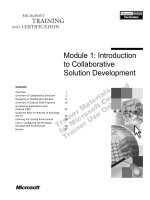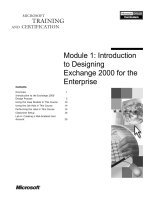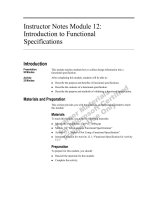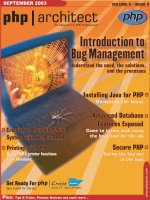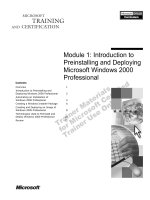Module 1 introduction to networking management 2s
Bạn đang xem bản rút gọn của tài liệu. Xem và tải ngay bản đầy đủ của tài liệu tại đây (382.43 KB, 17 trang )
9/7/2014
1
Module 1: Introduction to
Networking Management
Overview
• What is network management?
• Why manage network?
• Challenges in managing enterprise
networks
• Network management areas
• Implications for management
9/7/2014
2
What is Network Management ?
• In general, network management is a service that employs a variety
of tools applications and devices to assist human network
of
tools
,
applications
,
and
devices
to
assist
human
network
managers in monitoring and maintaining the performance of
networks.
• Network management means different things to different people. In
some cases, it involves a solitary network consultant monitoring
network activity with an outdated protocol analyser. In other cases,
network management involves a distributed database, auto-polling
of network devices, and high-end workstations generating real-time
graphical views of network topology changes and traffic
graphical
views
of
network
topology
changes
and
traffic
.
*Ref CISCO Systems Website
What is Network Management –
2
• Network management refers to the activities, methods,
d d t l th t t i t th ti
proce
d
ures, an
d
t
oo
l
s
th
a
t
per
t
a
i
n
t
o
th
e opera
ti
on,
administration, maintenance and provisioning of networked
systems.
• Functions performed as part of network management include:
– controlling, planning, allocating, deploying, coordinating and
monitoring the resources of a network,
– network planning, frequency allocation and predetermined traffic
routing to support load balancing,
thikditibti
th i ti
dit
–
cryp
t
ograp
hi
c
k
ey
di
s
t
r
ib
u
ti
on, au
th
or
i
sa
ti
on an
d
secur
it
y
management
– configuration management, fault management, performance
management, bandwidth management; and accounting
management
9/7/2014
3
Why bother with Network
Performance Management ?
Typical Performance Metrics
• Mean Time Between Failures (MTBF)
•
Mean Time to Repair (MTTR)
Mean
Time
to
Repair
(MTTR)
• Response Time
• Speed
• Percentage Availability
• Reliability
• Errored Seconds
Bit E R t (BER)
•
Bit
E
rror
R
a
t
e
(BER)
• Voice Quality
• Others ?
9/7/2014
4
When things Fail
This is an example of the case where if any one device or
process fails the whole device or process has failed.
When things Fail
This is an example of the case where if any one device or process fails
the whole device or process has failed.
9/7/2014
5
When things Fail
This is an
example of
example
of
the case
where all
devices
must fail for
the whole
the
whole
device or
process to
fail.
However !
Network Performance Management Costs Money
– Administrative Overheads
– Equipment
– Links and bearers
– Protocol Overheads
Processing and Software Overheads
–
Processing
and
Software
Overheads
–Etc.
9/7/2014
6
The Process for Business Grade
Networking
(Cisco Systems, 2010)
Why Manage your Network?
• Managing the network overall:
Investments in faster servers better protocols high
speed backbones
–
Investments
in
faster
servers
,
better
protocols
,
high
-
speed
backbones
and virtualised services have turned yesterday’s low-speed, data-only
networks into information technology platforms supporting a multitude of
business services.
– The redundancy and rerouting designed into these networks has mostly
hidden actual hardware or circuit outages from end users.
• Managing network performance:
– The bigger challenge is how to address the often-persistent intermittent
li i d d i h h
app
li
cat
i
on
d
egra
d
at
i
ons t
h
at represent a t
h
reat to revenue, customer
service and reputation.
– The packets transporting business applications throughout a global
network can be leveraged for analysis to achieve the highest level of a
network operations maturity process.
– The reward for using these packets as evidence and implementing a
mature management process for troubleshooting will be dramatic
reductions in mean time to restore (MTTR) application services.
(Haggerty, 2008)
9/7/2014
7
High Cost of Non-
Responsiveness
• Corporations Can Lose Millions of Dollars in Just One Hour If a
Mission-Critical Application Becomes Unavailable or Does Not Run
Correctly, Quickly or Completely
Business Average US$ Cost per Hour
Brokerage Operations $6.45 Million
Credit Card Authorisation $2.6 Million
Home Shopping TV $113,000
Pay-per-View TV $150,000
Catalog Sales $90,000
Airline Reservations $89,500
Tele-Ticket Sales $69,000
Package Shipping $28,000
ATM Fees $14,000
Source: Contingency Planning Research
How Much Management?
• Today’s computer and communications
ft d h d h l
so
ft
ware an
d
h
ar
d
ware
h
ave very
l
arge
amounts of management capability built in.
• It is also possible to install additional
software and hardware and other tools for
the express purpose of more detailed
the
express
purpose
of
more
detailed
management.
9/7/2014
8
5 Challenges in Managing
Enterprise Networks
• Lack of high-definition visibility
A minute is an eternity for applications like automated market trading and waiting
–
A
minute
is
an
eternity
for
applications
like
automated
market
trading
,
and
waiting
for medical images to appear can impact treatment options
• A unified network can no longer be managed as multiple traffic
silos
– In the modern, fully converged IP network, voice, video and data compete for
common resources and can affect one another’s –even if individual applications
seem to be working properly
• You cannot manage what you cannot see
– In dealing with service-oriented architecture-based applications, trouble-shooting
must start at the virtual service network level –not the physical network level
• Monitoring health of infrastructure elements is helpful
– But also depends on the interaction and communications between network
elements
• Must be able to identify business use vs. recreational use vs.
security threats
– Recreational use often presents itself as legitimate traffic from users to a legacy
management tool
The Impact of Unmanaged
Services
Network Outages
Cost money directly
•
Cost
money
directly
– E.g. banks, airlines, transaction services
• Cost money or Customers Indirectly
– E.g. ISP’s, Telco’s etc.
Outages may ultimately cause an organisation
to go out of business
9/7/2014
9
Views of Network Management
•CEO view
–
financial mana
g
ement of cor
p
orate comms network
gp
• management of orders, inventory, accounting information
• CIO view
– corporate budget
– end-user perspective
– providing more service with less money
• End User view
– require data comms infrastructure to be working at all
times
Outsourcing
• Work does not stop when outsourcing to
SiPid
S
erv
i
ce
P
rov
id
ers
• No Service Providers will sign Unlimited
Liability Liquidated Damages contracts
• Network outages can kill companies
9/7/2014
10
Network Management
Requirements
• Fault Management
• Accounting Management
• Configuration and Name Management
• Performance Management
• Security Management
Fault Management
•
A
fault is an abnormal condition that
requires management attention (or
action) to repair.
How do you define
abnormal
?
How
do
you
define
abnormal
?
9/7/2014
11
Setting the Threshold
• It is important to set the threshold for alarm
indications to an appropriate level so that
indications
to
an
appropriate
level
,
so
that
significant faults and quality of service issues
can be dealt with without the network
manager becoming overloaded with the
relevant messages.
• Excessive network mana
g
ement
,
and
g,
excessive network management messages
can actually degrade overall network
performance.
Accounting Management
• Reasons for accounting management:
Internal
charge backs
on net ork se
–
Internal
charge
backs
on
net
w
ork
u
se
– User(s) may be abusing access privileges
and burdening the network at the expense of
other users
– Users may be making inefficient use of the
network
– The network manager is in a better position to
plan for network growth if user activity is
known in sufficient detail.
9/7/2014
12
Configuration Management
Concerned with:
•
Concerned
with:
– initialising a network and gracefully shutting
down part or all of the network
– maintaining, adding, and updating the
relationships among components and the
status of components themselves during
tk ti
ne
t
wor
k
opera
ti
on
Adds, Moves and Changes
Security Management
• Concerned with:
–
monitoring and controlling access to networks
– generating, distributing, and storing
encryption keys
– access to all or part of the network
management information
– collection, storage, and examination of audit
records and security logs
9/7/2014
13
Performance Management
• Some typical issues of concern to the network manager
include:
include:
– What is the level of capacity utilisation?
– Is there excessive traffic?
– Has throughput been reduced to unacceptable levels?
– Are there bottlenecks?
– Is response time increasing ?
– Are customers getting what they paid for ?
• Network managers need performance statistics to help
them plan, manage and maintain large networks
Web-based Network
Management
• User interface using web technology
–
HTML pages delivered via HTTP over TCP
– platform independence
– network management information stored on
web servers
9/7/2014
14
Key challenges
• Shift to LANs and the Internet
– Large scale move from using mainframes and terminals to PCs, LANs and the Internet.
Future of network management lies in the successful management of multiple clients and servers over
•
Future
of
network
management
lies
in
the
successful
management
of
multiple
clients
and
servers
over
LANs, BN’s, and Internet
• Focus on integration of organisational networks and applications. Main
problems:
– Not all LANs use the same architecture
– More types of network technology used, the more complex network management becomes
•
Integrating LANs WANs and Internet
•
Integrating
LANs
,
WANs
and
Internet
– Both LAN/Web and WAN managers to recognise that they no longer have total power
– Must adopt a written charter to define its purpose, operational philosophy, and long range
goals
– Must develop individual procedures to implement policies
(Copyright2010JohnWiley&Sons,Inc)
Key Challenges…
• Integrating Voice & Data –Traditionally, traditional voice and
data networks (e.g., POTS and LANs) were handled by
separate managers
separate
managers
– Voice Communication Manager in Facilities Department:
• Supervised telephone switchboard, coordinated installation and
maintenance of the voice network
– Data Communication Manager (IT department):
• Installed own data circuit, installed and maintained computers
• Now, organisations realise benefits of integrating voice and
data management function
data
management
function
– Simplifies the network, and can lower network costs
– Eliminates one department
– Is now more typically found in network management
(Copyright2010JohnWiley&Sons,Inc)
9/7/2014
15
Improving performance
• General activities to improve performance that cut across the
different types of networks:
Pli
bd t
S tti i it li i f t k
–
P
o
li
c
y
-
b
ase
d
managemen
t
-
S
e
tti
ng pr
i
or
it
y po
li
c
i
es
f
or ne
t
wor
k
traffic in software and configures devices using QoS capabilities
in TCP/IP and/or ATM
• Example-Manager: Sets videoconferencing traffic as the highest priority
since delays will have the highest impact on the performance of that
application
– Server load balancing-Used to allocate incoming requests for
network servers and uses a separate load balancing server (or a
router/switch) with a special software
Service
level agreements
Signed between the organization
–
Service
-
level
agreements
-
Signed
between
the
organization
and its service providers (ISP or common carriers)
• Specify the exact type of performance and fault conditions that the
organization will accept
• Examples-Availability must be 99% or higher
• Maximum allocable response time must be lower than 2 minutes
(Copyright2010JohnWiley&Sons,Inc)
Cost Management
• One of the most
challen
g
in
g
gg
areas over the
past few years
– Traffic growing
more rapidly
than the
budget
– Managers are
forced to
provide greater
capacity at an
ever lower cost
per megabyte
(Copyright2010JohnWiley&Sons,Inc)
9/7/2014
16
Sources of Cost
• Total Cost of Ownership
(TCO)
Afhh
–
A
measure o
f
h
ow muc
h
it costs per year to keep
one computer operating
– Includes cost of
• Repairs and
software/hardware
upgrades
• Support staff (maintain,
install administer etc)
install
,
administer
,
etc)
• Training and technical
support
• Time “wasted” by the
user when problems
occur
(Copyright2010JohnWiley&Sons,Inc)
Implications for Management
• Network management requires
– A good understanding of networking technologies
A bili k i h d d
–
A
n a
bili
ty to wor
k
w
i
t
h
en
d
users an
d
management
– An understanding of key elements driving network costs
– Requires special skill to explain the business value of the
networks to senior management
– Needed to justify increased cost of management
• Recommendations
–
Develop strong relationships with only few vendors
Develop
strong
relationships
with
only
few
vendors
– Purchase technologies that will provide strong network
management capabilities
– Use powerful design and management tools-Saves money in the
long run
(Copyright2010JohnWiley&Sons,Inc)
9/7/2014
17
References
• CA (2008) Strategic Planning for Network and Systems
Mt
ThT tWhit
P A il bl li
M
anagemen
t
,
T
ec
hT
arge
tWhit
e
P
aper,
A
va
il
a
bl
e on
li
ne: :
/>• Cisco (2008) Network Management Basics, InInternetworking
Technology Handbook, Available online:
/>handbook/NM-Basics.html
• Haggerty, E. (2008) Overcoming Today’s IP Network
Challenges, Newsfactor.com White Paper, Available online:
htt // f t / t ht l? t id 013000FA05
htt
p:
//
www.news
f
ac
t
or.com
/
s
t
ory.x
ht
m
l?
s
t
ory_
id
=
013000FA05
2E&page=1
• Wikipedia (2008) Network Management, Available online:
/>References
• Stallings, W, 2005, Section 19.1 –‘Business Data Communications’, 5th
edn
, Pearson Education Inc., New Jersey.
edn
,
Pearson
Education
Inc.,
New
Jersey.
• Cisco Systems Inc, 2006, ‘Simple Network Management Protocol’,
Internetworking Technologies Handbook, Chapter 56, Cisco Systems Inc.
www.Cisco.com.
• FitzGerald, J and Dennis, A, 2005, Chapter 13 –‘Business Data
Communications and Networking’, 8th edn, John Wiley & Sons, Inc., New
Jersey.
• FitzGerald, J and Dennis, A, 2010, Chapter 12 –‘Business Data
Communications and Networking’, 10th edn, John Wiley & Sons, Inc., New
Jersey.
T E Eddi B d M tt B 2006 ‘C i f SNMP V i 1 2
•
T
ang,
E
,
Eddi
e,
B
an
d
M
a
tt
,
B
2006
,
‘C
ompar
i
son o
f
SNMP
V
ers
i
ons
1
,
2
and 3’;
• WindowsNetworkig.com n.d,‘Understanding the SNMP Protocol’ -
www.windowsnetworking.com
• CP3340 Communication Systems-‘SNMP Environment’, www.scit.wlv.ac.uk

